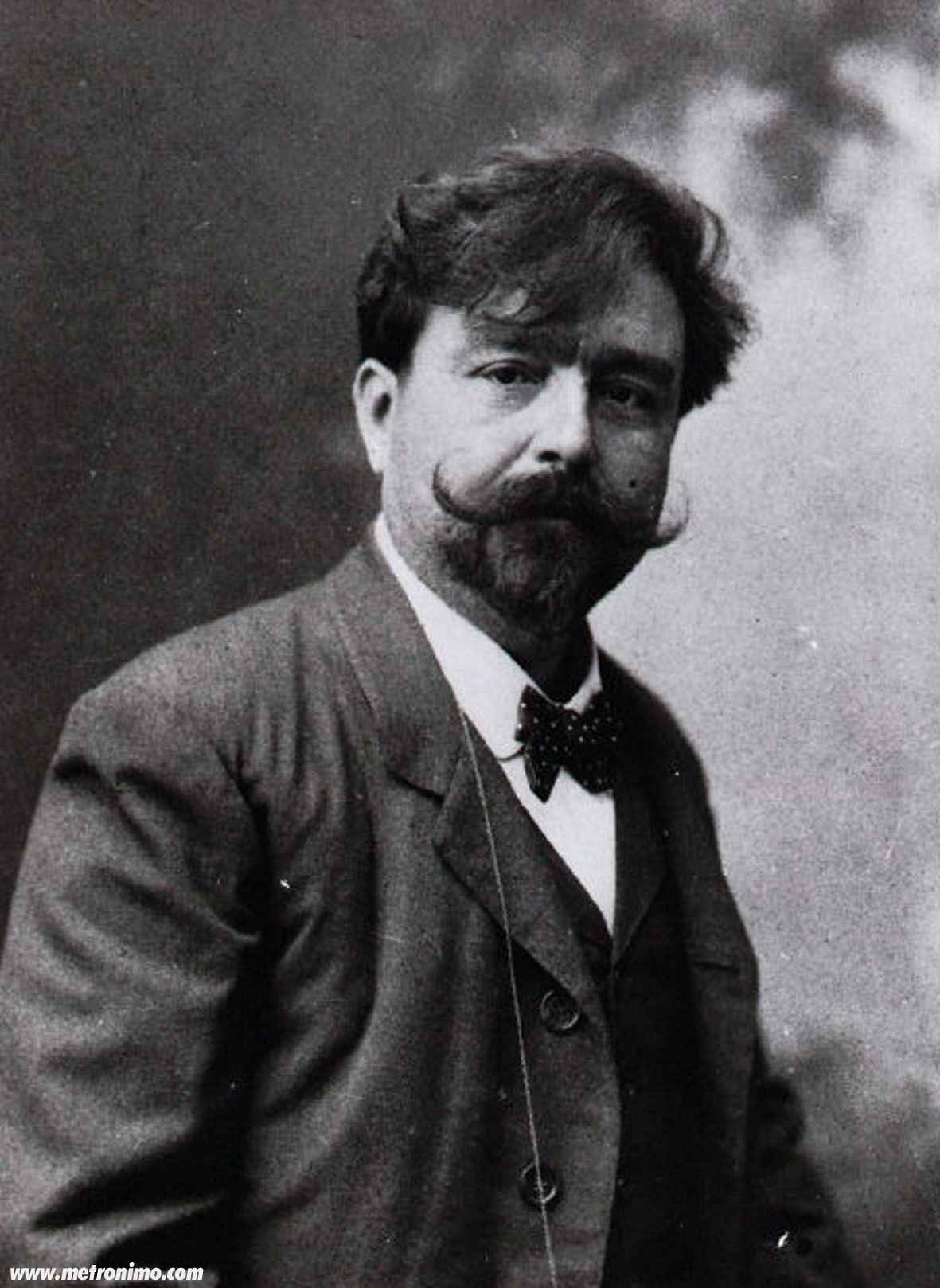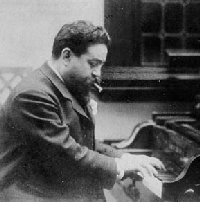 Ever
since hearing one of my school friends
play Albéniz’s Cordoba
I have been quite an enthusiast of the
music of this great Spanish Composer.
However, in some ways it is quite difficult
to get a handle on his works – he appears
to have composed a vast number of pieces
for piano – just take a few moments
to check out the list in Grove to see
the scale of the problem. Of course,
there are a few signposts - the most
popular work is quite definitely Iberia:
there are some twenty-nine recordings
of this masterwork along with countless
examples of individual numbers from
this work.cycle. Asturias, from
the Suite Española is
the ‘Top of the Albéniz
Pops’ – but this is a bit of a cheat,
for the number of recordings includes
the guitar version as well as the one
for piano. Most lovers of piano music
will also know the unbelievably popular
Espana Suite - especially Tango,
Granada and Seville.
Ever
since hearing one of my school friends
play Albéniz’s Cordoba
I have been quite an enthusiast of the
music of this great Spanish Composer.
However, in some ways it is quite difficult
to get a handle on his works – he appears
to have composed a vast number of pieces
for piano – just take a few moments
to check out the list in Grove to see
the scale of the problem. Of course,
there are a few signposts - the most
popular work is quite definitely Iberia:
there are some twenty-nine recordings
of this masterwork along with countless
examples of individual numbers from
this work.cycle. Asturias, from
the Suite Española is
the ‘Top of the Albéniz
Pops’ – but this is a bit of a cheat,
for the number of recordings includes
the guitar version as well as the one
for piano. Most lovers of piano music
will also know the unbelievably popular
Espana Suite - especially Tango,
Granada and Seville.
This present CD has
a number of lesser known fine works
that well deserve to be known to enthusiasts
of piano music. Most of the workspieces
were composed during the composer’s
residence in Paris. Yet the longest
piece is in fact the romantic, Recuerdos
de viaje which was composed written
while the composer was still living
in Madrid.
The programme notes
define well the musical difference between
the works written in Spain and those
in Paris. The former are typically meditations
on nearby places, peoples and experiences
seen through the eyes of a ‘local’ or
perhaps a traveller. However the French
experience allowed the composer to reflect
on Spain from a distance – perhaps even
occasionally with the eye of a ‘foreigner.’
Yet all his works are imbued with the
spirit of Spain and form an important
part of the repertoire of pianists.
 The
Recuerdos de viaje, Op. 71 (B
18) were composed in Madrid in 1887.
The composer and his family had just
moved there. Over the next few months
Albéniz was to have a series
of ups and downs in his professional
and private life. He was successfully
established as a composer and pianist
in January 1886 after his momentous
recital in the rooms salon of his publisher,
Antonio Romero. However, just a few
weeks later his daughter Blanca died.
Yet the present work does not explore
these events: there is no suggestion
of tragedy or exaltation in these seven
works.pieces. It would be wrong to suggest
that they are it is simply salon music,
but the purpose was to entertain rather
than inform. The title of the work means,
roughly, ‘Travel Reminiscences’. Some
clues as to the titles of each piece
may be of help to the non-Spanish speaker.
En el mar was issued in London
entitled On the Water. Puerta
de tierra is an architectural landmark
in Cadiz, Rumores de la caleta
can be rendered as ‘Murmurs in the
Cove’ and lastly En la playa
is On the Beach.
The
Recuerdos de viaje, Op. 71 (B
18) were composed in Madrid in 1887.
The composer and his family had just
moved there. Over the next few months
Albéniz was to have a series
of ups and downs in his professional
and private life. He was successfully
established as a composer and pianist
in January 1886 after his momentous
recital in the rooms salon of his publisher,
Antonio Romero. However, just a few
weeks later his daughter Blanca died.
Yet the present work does not explore
these events: there is no suggestion
of tragedy or exaltation in these seven
works.pieces. It would be wrong to suggest
that they are it is simply salon music,
but the purpose was to entertain rather
than inform. The title of the work means,
roughly, ‘Travel Reminiscences’. Some
clues as to the titles of each piece
may be of help to the non-Spanish speaker.
En el mar was issued in London
entitled On the Water. Puerta
de tierra is an architectural landmark
in Cadiz, Rumores de la caleta
can be rendered as ‘Murmurs in the
Cove’ and lastly En la playa
is On the Beach.
The Espagne (Souvenirs)
are not to be confused with the two
Suites Españolas
which González recorded in the
first volume one of this edition. The
present suite was composed around 1896
when Albéniz was in Paris. There
are only two pieces – a Prélude
and Asturias - which refers to
a district in Northern Spain.
The Prélude
begins quietly but soon becomes more
animated: as the piece develops the
Spanish mood becomes more and more evident.
Yet there is a dichotomy here: the middle
section of this piece leans towards
dissonance and explores a language less
typically Iberian. Yet somehow the two
moods co-exist and after a brief protest
conclude quietly. Asturias is
a sad little piece. The Spanish flavour
is less in evidence and it has been
said that perhaps Debussy is an influence
here. The music is typically restrained
with the middle section being a little
more complex. In all it is a truly magical
piece.
Azulejos was
one of the last works written by the
composer – in fact it was completed
by Enrique Granados after the Albéniz’s
death. This is an excellent piece of
music that explores a pianism quite
removed from the early Spanish ‘postcard’
number. This is a valedictory workpiece
that combines subtlety with exquisite
craftsmanship and emotional depth. Azulejos
means in Spanish ‘Tiles’ or perhaps
‘Mosaics.’ This work was to have been
part of an eponymous cycle of pieces.
It is one of the great works by Albéniz
and deserves much more exposure. There
are only two recordings of this work
in the catalogue at present.
La Vega ‘Fantasie
espagnole’ (1897) is a big work
and is regarded by many as being the
epitome of Isaac Albéniz’s mature
piano style. The piece was originally
conceived as a part of a cycle called
‘Alhambra’ – but this was never
completed. Apparently the composer wrote,
somewhat enigmatically, that ‘in this
piece one can see the entire plan (vega)
of Granada as contemplated from the
Alhambra.." There is a perfection
in this music that defies description
– the more one listens to it the more
one is amazed by its beauty. It lasts
for nearly sixteen minutes – anything
less and the listener would certainly
feel short-changed!.
There are two versions
of Navarra in existence- neither
wholly by Albéniz.. After his
death, aged 49, it was completed by
the composer’s student Déodat
de Severac. In later years William Bolcom
did another version – the difference
being that he provides a newly
composed conclusion whereas de Severac
just ended the piece in mid-stream.
We hear the latter version here. It:
it is a good piece to conclude this
interesting and often moving exploration
of Albéniz’s piano music.
I note that this is
Volume 2 of the piano music of Isaac
Albéniz.. The first included
the big works – Iberia and España
1 & 2. Yet if Naxos intends
to realize a ‘complete’ edition of the
piano works, then there are many volumes
still to come. I can only hope that
this project does not go the way that
a number of others have gone – I think
of Liszt and Ireland.
It is essential that
we have an easily available edition
of this music. I look forward to subsequent
releases and am confident that Guillermo
González is the man to do them.
For too long it has been assumed that
Alicia De Larrocha - brilliant as she
is - had the monopoly on Spanish piano
music.
John France
I look forward to subsequent Albéniz
releases and am confident that Guillermo
González is the man to do them. ...
see Full Review

